dude, i am not half the player u are but i am considering sid. i am thinking religious, seafaring or seafaring commercial. And large archipielago with very early attacks. It will probably take many tries and will bust my mind but its posible... theoretically.
You are using an out of date browser. It may not display this or other websites correctly.
You should upgrade or use an alternative browser.
You should upgrade or use an alternative browser.
The Chronicles of Khan
- Thread starter Sandman2003
- Start date
Sandman2003
Prince
I am not actually convinced that Sid makes for particularly enjoyable games, even for the elite players who can reasonably expect to best it. The victories on Sid, that I have seen written up here, have either had numerous restarts until 'ideal' conditions have been met (eg SirPleb's Hall of Fame Sid game, or Arathorn's All War Sid game), or they involved a good degree of luck with food bonuses and directions the Sid AI have chosen to expand into (in the succession game threads).
I think that is why many elite players now seem to opt for playing variations where they deliberately impose restrictions on the tactics they can employ to beat the AI, as a means to make the game more challenging, but still retain fun elements. I can still see a gap between myself and the true elite of the game, too!
I will say this, though, if I find large deity continents, or large deity pangea a walk in the park, then perhaps I will try Sid!
I think that is why many elite players now seem to opt for playing variations where they deliberately impose restrictions on the tactics they can employ to beat the AI, as a means to make the game more challenging, but still retain fun elements. I can still see a gap between myself and the true elite of the game, too!
I will say this, though, if I find large deity continents, or large deity pangea a walk in the park, then perhaps I will try Sid!
Sandman2003
Prince
If you are going to go for Sid, El Loco, I think you would want militaristic in the traits as well - to get those powerful C3C armies happening that much sooner. I would have thought that it would be more useful than relegious or commercial, unless you particularly like the UU that you get with the other combinations.
Sandman2003 said:And in sight of this Mongol-Japanese War, the Dutch won the race to the old American city of Artaxata and settled a new colony, Delphi.
Dutch city of Delphi? you sure about that?
Sandman2003
Prince
No I am not sure about that at all. Good spotting. It was of course the Dutch city of Delft. I guess it comes from starring at Civ too long....rbis4rbb said:Dutch city of Delphi? you sure about that?
T-Money
Conquestador
Haven't checked in for some time due to a lot of schoolwork, but it looks like this story is still going really well. And, seeing as how the earliest part of this page was devoted to discussion of Sid, I just felt like dropping this little tidbit; it starts off really easy, at least for me, but snowballs and gets REALLY hard around about Monarchy-Fuedalism area on the tech tree. I started a war and captured 1 city before being obliterated.
I think I'm going to stick with Monarch for a while.
Great job with the updates, Sandman. Glad to see you haven't stopped yet.
I think I'm going to stick with Monarch for a while.
Great job with the updates, Sandman. Glad to see you haven't stopped yet.
T-Money
Conquestador
Whoa. I just looked back at that minimap and realized that with the Japanese and German territories added to your empire, you own about half the world.
Sandman2003
Prince
Actually, T-Money if I had filled out all the terrain with culture expansions I think it would be about 30% - this is a very large world!
T-Money
Conquestador
Yeah, well, in the grand scheme of things 50% and 30% are roughly the same j/p. Seriously, though, that is a big empire! I was inspired to start my own huge-map pangea game this morning, but it doesn't work nearly as well for me as it does for you.
biggamer132
King
Lol Sand, looks like the huge map is kind of a shock. I always play on it, because I'm a complete builder and play to maintain instead of to win. Still, once you get used to how long it takes, it can be pretty fun.
T-Money
Conquestador
Eh.......I may have already asked this question, but what's the world seed on this map? I want to play it as the Mongols with the same start and see how I do.
Fundamentality
WEE A PLANE!!!
It's been a few days already.Could you hurry a little with the next chapter  ?
?
 ?
?T-Money
Conquestador
Only 4 days.....although it is getting a little lonely in here. No hurry though, quality in a story beats quantity any day.
Sandman2003
Prince
I agree that it is a good policy to avoid civs when they have their UU, as much as possible, because the civ typically has an advantage in unit power or unit cost etc over you, and will benefit from a GA during hostilities. In this case, the Chinese have only just got their Riders, and after all it is cavalry versus riders, so it seems like a good idea to stop them now before they have the numbers to actually be a threat. Besides, it is actually a moot point now, as I have played through the chapter and just need to write it up.rbis4rbb said:Sandman I believe you you should hit the Portugese next. Chinese later, because the Rider is really strong now.
biggamer132 - I was expecting the game to take a while, both in terms of time per turn, and turns required to win the game. I also had an expectation that playing a huge pangea would prove more difficult on the given level than a smaller map on either continents or archipelago. On this latter point, I haven't really found it so, just different, although I can see why being isolated in archipelago is an advantage on very difficult levels.
Sandman2003
Prince
T-Money the world seed is in the first post.

 Haven't you been waiting like 2 months since Daft's last post? I will hopefully be able to post the next chapter later today.
Haven't you been waiting like 2 months since Daft's last post? I will hopefully be able to post the next chapter later today.
rbis4rbb said:Ok Daft come on

 Haven't you been waiting like 2 months since Daft's last post? I will hopefully be able to post the next chapter later today.
Haven't you been waiting like 2 months since Daft's last post? I will hopefully be able to post the next chapter later today.Sandman2003
Prince
Chapter Fourteen: The Byzantine - Mongol Pact
Shortly after the final Mongolian victory over the Japanese, Queen Theodora of the Byzantines met with the Khan. The purpose of Theodora’s visit was to speed up the timetable on the execution of the mighty plan drawn up between these two great nations for the division of the northern Sino-American peninsular. The Byzantines had picked up a couple of Russian cities and a couple of German cities in the prior actions, but they wanted to gain the much bigger prize of the absorption of the Chinese lands as per the original plan. The campaign was to be in two parts – first the conquest of China, then the combined forces of the Mongols and Byzantines would turn onto America. At the conclusion of the campaign, the conquered territories would be split along the lines of China becoming part of a greater Byzantine core, and America being absorbed into the Mongolian empire.
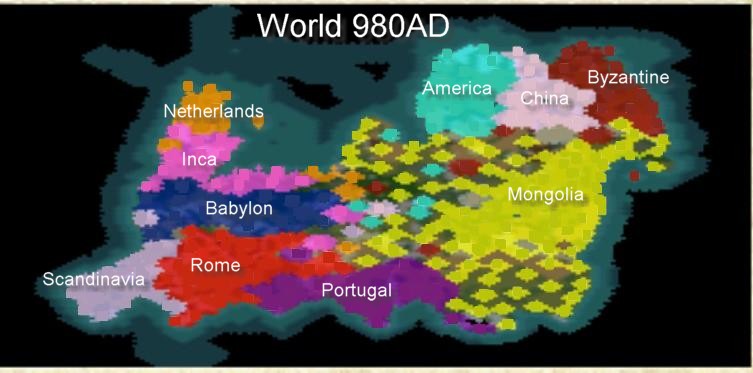
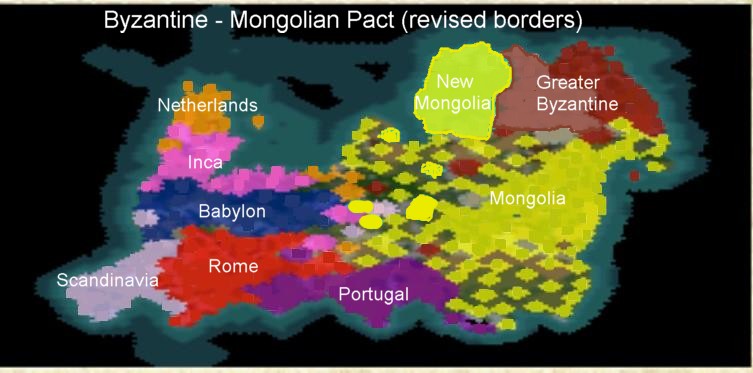
The Khan was able to reassure Theodora that even as they spoke, the mighty forces of the Mongolians were making the long trek to the Chinese borders to commence the execution of the Chinese campaign. The plan called for Subedei’s forces to strike into China from three separate locations. In the south, Subedei’s primary force would base itself from the town of Yekaterinburg and strike north at the Chinese town of Xinjian. In the southeast, Subedei would have a second force ready in Yakutsk to strike north towards the town of Tsingtao. Subedei’s third force would come from the far north west, in what was currently American territory, and hit the northern Chinese town of Tientsin. Meanwhile the Byzantines were expected to storm in form the mid-east aimed at the city of Canton.
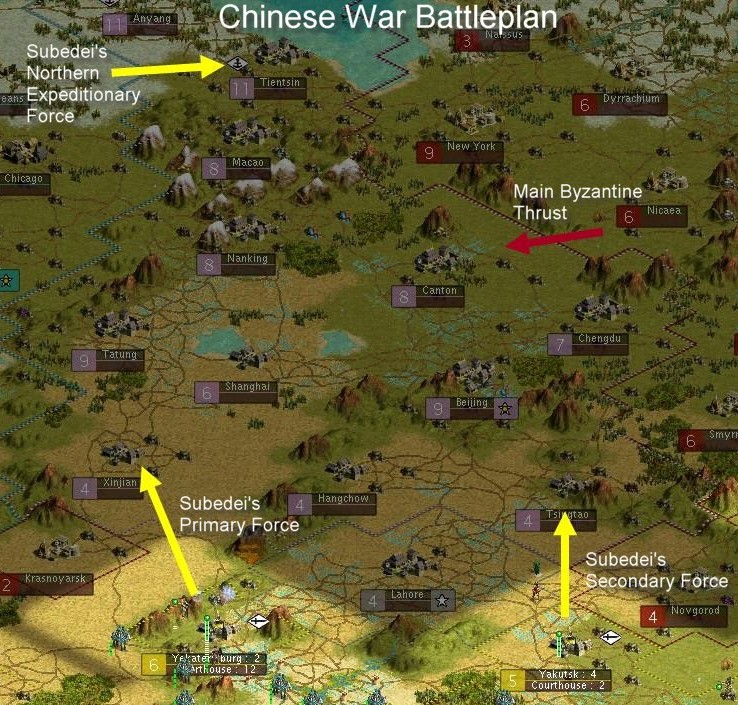
The only caveat on this whole operation was that Subedei’s forces would not be in position until 1040AD, such was the time required to cross the huge Mongolian empire, even with the very fast new cavalry units. And so, reassured that the plan was on track, Theodora left.
As Subedei’s forces advanced to their collection points, other significant events occurred within the Mongolian empire. First of all, Kublai finally completed his long trek in from the west, and after his triumphant march through the streets of Karakorum, Kublai was to lead the people in a mighty project. Such was the esteem within which the Mongolian people held their military heroes that Kublai’s exuberant followers completed his project in record time.
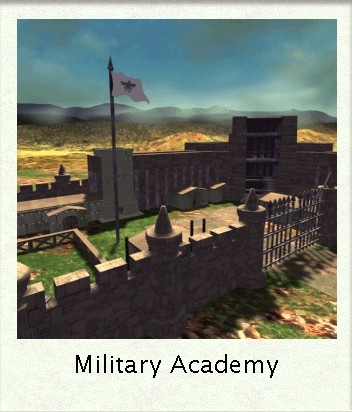
The new military training facility promised to be able to strengthen the mighty Mongolian armies even further, and to provide a mechanism for a more predictable development of new armies, and a greater quantity of them as well. The scientific front continued to herald in new developments as well. Although Yeh-lu noted with a degree of concern how the Byzantines actually researched the concept of physics just slightly faster than the Mongols’ own sages. What is more, they were not willing to share this knowledge in the spirit of the Byzantine – Mongolian Pact. It mattered not, for shortly thereafter, the Mongolian sages were to announce their own progress in this concept.
Over this past millennium, Yeh-lu had noted that the Mongolian Monarchy had been growing increasingly ineffective in controlling the rapidly expanding Mongolian empire, with the far outlying towns effectively so corrupt as to be yielding almost nothing of value to the Khan’s empire. With this in mind, Yeh-lu was noting the renaissance of achievement in the Mongol’s ally the Byzantines, following their switch to the highly representative Democracy government form. Although clearly the size of empire was very different, it was quite sobering to see the progress made by a ‘democratic’ government in comparison to the Mongols’ monarchy. At the very least, it was clearly essential that the Mongols understand this concept fully, so that a strategic decision on the future could be made.
It was therefore, with the Khan’s blessing that immediate arrangements were made to trade with the Dutch for the secrets to this different government form.

As the sages looked to improve their understanding of gravity, they were rewarded with improved funding. The Khan did not wish to be left behind in the tech race!
In other international affairs at this time, it was now the turn of the Romans to come seeking an alliance against the Babylonians in the ongoing conflict amongst those two nations. Both nations continued to struggle to build sufficient force to seriously challenge the other, and were completely stagnating in terms of technical achievement, as this stalemate continued. But the Khan had no interest in changing this situation at all. The Roman ambassador was rebuffed on the alliance, but granted the right of passage, though it was not expected to be particularly useful to them.
It was also noted that the Scandinavians were persisting in trespass across the Mongolian nation. However, this action appeared to be aimed at pursuing the remnants of the Indian civilisation, as the Scandinavians continued their war against the Indians. The Khan considered that the numbers of units involved were small, and their cause was just. Why not let them continue to destroy the Indians?
In the final major event prior to the outbreak of hostilities, the special project sponsored by Adam Smith was finally completed in the city of Tabriz. As promised this ‘trading company’ did indeed improve commerce in the empire quite significantly.

Subedei’s time had at lat arrived, with troops in position at the two main staging points, and with the third well on its way. Subedei could wait no longer! Chebe advised the Khan that everything was in position for the Chinese campaign, and so the Chinese ambassador was invited to the Karakorum palace. The Khan had trumped up what he thought would be outrageous demands to test the mettle of the Chinese. A demand was made to the Chinese for a slave worker gang, their world amp and the entire Chinese treasury (3 gold). Fearing the worst, the Chinese acquiesced to these demands immediately. This was not the expected reaction from the once proud Chinese! The Chinese were not to be given their period of peace that they hoped this meagre tribute would buy, however, for the Khan followed up this demand with a war declaration. Three gold was deemed insufficient – the Chinese needed to grant a substantially larger payment for the right to continued existence. Subedei was given the go ahead.
But even before Subedei could act, Yeh-lu was informing the Byzantines that the time had come, and invited them to join in the action as dictated by the Pact between the two nations. But much to his surprise, Yeh-lu did not find Theodora as cooperative as expected. To get the Byzantines to act on their side of the Pact, Yeh-lu had to sweeten the deal with a transfer of Mongolian furs. What exactly were these ‘allies’ upto?
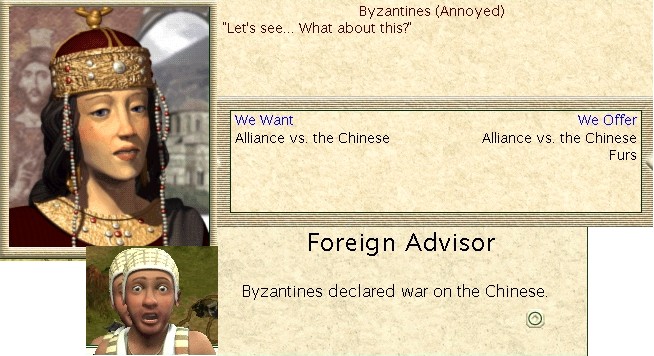
The Byzantines had initially asked for saltpetre, but the ever clever Yeh-lu convinced them to accept furs instead. This would currently limit the Byzantine assault forces to knights rather than the more powerful cavalry, and limit their defensive forces to pikes instead of muskets. And perhaps, given the deviousness of the Byzantine actions so far this was a very necessary move!
The Byzantine weirdness grew further. Their first action was to befriend the Americans, the supposed second foe of the Pact, and bring them into the Chinese action as well. Theodora explained it away as simply a means to weaken the American forces before the combined assault of the Byzantines and the Mongols, however, some in the Khan’s court had become a lot less convinced about the Byzantine intentions, and this further reinforced that view.
But now Subedei’s secondary force had reached the gates of Tsintao, and once again the brief peace of the Mongols was to be shattered with a new war. At Tsingtao, the mighty Chinese rider was met in battle for the first time, but this matchup was to be cavalry versus rider, not the Keshik that the Chinese might have hoped for. The first clash, however, went largely the Chinese way. A single battalion of these Chinese Riders stubbornly held off, and destroyed two battalions of cavalry. Meanwhile Tolui’s army was engaged destroying a pike battalion and a further battalion of cavalry destroyed another pike battalion. It took a third cavalry battalion to finally broadside these riders and smash the way into the town. So while the Chinese did lose the town, their riders had certainly proven their worth in this first battle.
Subedei’s main force was to launch an assault from the plains by the Byzantine town of Krasnoyarsk to the Chinese town of Xinjian. But, the Chinese had advanced two battalions of medieval infantry to the town of Krasnoyarsk already. Subedei contemplated leaving these inferior units to the Byzantines, but decided against it, because the Chinese might have time to interdict the all important Mongol supply lines, and so instead a cavalry battalion, and a keshik army were utilised in removing this threat.
At Xinjian, the riders again put up some resistance, as one might expect from the elite of a nations forces. However, as the second and third keshik armies aided the cavalry battalions in this assault, only a single Mongolian cavalry battalion fell as four rider, two pike and one medieval infantry battalion were destroyed in the Mongolian attack that seized control of the town. By the town, Chinese losses continued to mount as another medieval infantry battalion and a lowly warrior battalion were dispatched by keshik armies.
In the east, the Chinese struck back with riders ambushing a cavalry unit north of Yakutsk. However, the Byzantines did indeed enter the battle, and they were observed smashing a rider unit in revenge, so perhaps the Byzantines would see through their commitments after all! At Xinjian, a half division of riders attempted to mount a flanking action on the town in an obvious attempt to recapture it.
Shortly after the final Mongolian victory over the Japanese, Queen Theodora of the Byzantines met with the Khan. The purpose of Theodora’s visit was to speed up the timetable on the execution of the mighty plan drawn up between these two great nations for the division of the northern Sino-American peninsular. The Byzantines had picked up a couple of Russian cities and a couple of German cities in the prior actions, but they wanted to gain the much bigger prize of the absorption of the Chinese lands as per the original plan. The campaign was to be in two parts – first the conquest of China, then the combined forces of the Mongols and Byzantines would turn onto America. At the conclusion of the campaign, the conquered territories would be split along the lines of China becoming part of a greater Byzantine core, and America being absorbed into the Mongolian empire.


The Khan was able to reassure Theodora that even as they spoke, the mighty forces of the Mongolians were making the long trek to the Chinese borders to commence the execution of the Chinese campaign. The plan called for Subedei’s forces to strike into China from three separate locations. In the south, Subedei’s primary force would base itself from the town of Yekaterinburg and strike north at the Chinese town of Xinjian. In the southeast, Subedei would have a second force ready in Yakutsk to strike north towards the town of Tsingtao. Subedei’s third force would come from the far north west, in what was currently American territory, and hit the northern Chinese town of Tientsin. Meanwhile the Byzantines were expected to storm in form the mid-east aimed at the city of Canton.

The only caveat on this whole operation was that Subedei’s forces would not be in position until 1040AD, such was the time required to cross the huge Mongolian empire, even with the very fast new cavalry units. And so, reassured that the plan was on track, Theodora left.
As Subedei’s forces advanced to their collection points, other significant events occurred within the Mongolian empire. First of all, Kublai finally completed his long trek in from the west, and after his triumphant march through the streets of Karakorum, Kublai was to lead the people in a mighty project. Such was the esteem within which the Mongolian people held their military heroes that Kublai’s exuberant followers completed his project in record time.

The new military training facility promised to be able to strengthen the mighty Mongolian armies even further, and to provide a mechanism for a more predictable development of new armies, and a greater quantity of them as well. The scientific front continued to herald in new developments as well. Although Yeh-lu noted with a degree of concern how the Byzantines actually researched the concept of physics just slightly faster than the Mongols’ own sages. What is more, they were not willing to share this knowledge in the spirit of the Byzantine – Mongolian Pact. It mattered not, for shortly thereafter, the Mongolian sages were to announce their own progress in this concept.
Over this past millennium, Yeh-lu had noted that the Mongolian Monarchy had been growing increasingly ineffective in controlling the rapidly expanding Mongolian empire, with the far outlying towns effectively so corrupt as to be yielding almost nothing of value to the Khan’s empire. With this in mind, Yeh-lu was noting the renaissance of achievement in the Mongol’s ally the Byzantines, following their switch to the highly representative Democracy government form. Although clearly the size of empire was very different, it was quite sobering to see the progress made by a ‘democratic’ government in comparison to the Mongols’ monarchy. At the very least, it was clearly essential that the Mongols understand this concept fully, so that a strategic decision on the future could be made.
It was therefore, with the Khan’s blessing that immediate arrangements were made to trade with the Dutch for the secrets to this different government form.

As the sages looked to improve their understanding of gravity, they were rewarded with improved funding. The Khan did not wish to be left behind in the tech race!
In other international affairs at this time, it was now the turn of the Romans to come seeking an alliance against the Babylonians in the ongoing conflict amongst those two nations. Both nations continued to struggle to build sufficient force to seriously challenge the other, and were completely stagnating in terms of technical achievement, as this stalemate continued. But the Khan had no interest in changing this situation at all. The Roman ambassador was rebuffed on the alliance, but granted the right of passage, though it was not expected to be particularly useful to them.
It was also noted that the Scandinavians were persisting in trespass across the Mongolian nation. However, this action appeared to be aimed at pursuing the remnants of the Indian civilisation, as the Scandinavians continued their war against the Indians. The Khan considered that the numbers of units involved were small, and their cause was just. Why not let them continue to destroy the Indians?
In the final major event prior to the outbreak of hostilities, the special project sponsored by Adam Smith was finally completed in the city of Tabriz. As promised this ‘trading company’ did indeed improve commerce in the empire quite significantly.

Subedei’s time had at lat arrived, with troops in position at the two main staging points, and with the third well on its way. Subedei could wait no longer! Chebe advised the Khan that everything was in position for the Chinese campaign, and so the Chinese ambassador was invited to the Karakorum palace. The Khan had trumped up what he thought would be outrageous demands to test the mettle of the Chinese. A demand was made to the Chinese for a slave worker gang, their world amp and the entire Chinese treasury (3 gold). Fearing the worst, the Chinese acquiesced to these demands immediately. This was not the expected reaction from the once proud Chinese! The Chinese were not to be given their period of peace that they hoped this meagre tribute would buy, however, for the Khan followed up this demand with a war declaration. Three gold was deemed insufficient – the Chinese needed to grant a substantially larger payment for the right to continued existence. Subedei was given the go ahead.
But even before Subedei could act, Yeh-lu was informing the Byzantines that the time had come, and invited them to join in the action as dictated by the Pact between the two nations. But much to his surprise, Yeh-lu did not find Theodora as cooperative as expected. To get the Byzantines to act on their side of the Pact, Yeh-lu had to sweeten the deal with a transfer of Mongolian furs. What exactly were these ‘allies’ upto?

The Byzantines had initially asked for saltpetre, but the ever clever Yeh-lu convinced them to accept furs instead. This would currently limit the Byzantine assault forces to knights rather than the more powerful cavalry, and limit their defensive forces to pikes instead of muskets. And perhaps, given the deviousness of the Byzantine actions so far this was a very necessary move!
The Byzantine weirdness grew further. Their first action was to befriend the Americans, the supposed second foe of the Pact, and bring them into the Chinese action as well. Theodora explained it away as simply a means to weaken the American forces before the combined assault of the Byzantines and the Mongols, however, some in the Khan’s court had become a lot less convinced about the Byzantine intentions, and this further reinforced that view.
But now Subedei’s secondary force had reached the gates of Tsintao, and once again the brief peace of the Mongols was to be shattered with a new war. At Tsingtao, the mighty Chinese rider was met in battle for the first time, but this matchup was to be cavalry versus rider, not the Keshik that the Chinese might have hoped for. The first clash, however, went largely the Chinese way. A single battalion of these Chinese Riders stubbornly held off, and destroyed two battalions of cavalry. Meanwhile Tolui’s army was engaged destroying a pike battalion and a further battalion of cavalry destroyed another pike battalion. It took a third cavalry battalion to finally broadside these riders and smash the way into the town. So while the Chinese did lose the town, their riders had certainly proven their worth in this first battle.
Subedei’s main force was to launch an assault from the plains by the Byzantine town of Krasnoyarsk to the Chinese town of Xinjian. But, the Chinese had advanced two battalions of medieval infantry to the town of Krasnoyarsk already. Subedei contemplated leaving these inferior units to the Byzantines, but decided against it, because the Chinese might have time to interdict the all important Mongol supply lines, and so instead a cavalry battalion, and a keshik army were utilised in removing this threat.
At Xinjian, the riders again put up some resistance, as one might expect from the elite of a nations forces. However, as the second and third keshik armies aided the cavalry battalions in this assault, only a single Mongolian cavalry battalion fell as four rider, two pike and one medieval infantry battalion were destroyed in the Mongolian attack that seized control of the town. By the town, Chinese losses continued to mount as another medieval infantry battalion and a lowly warrior battalion were dispatched by keshik armies.
In the east, the Chinese struck back with riders ambushing a cavalry unit north of Yakutsk. However, the Byzantines did indeed enter the battle, and they were observed smashing a rider unit in revenge, so perhaps the Byzantines would see through their commitments after all! At Xinjian, a half division of riders attempted to mount a flanking action on the town in an obvious attempt to recapture it.
Sandman2003
Prince
Chapter Fourteen continued
This flanking action posed the most immediate danger to Subedei’s forces, so he ordered that it be dispatched with haste. However, protected as they were by the forests, these riders continued to put up a stiff resistance. No less than three keshik armies were employed in this battle with two facing such serious war damage from destroying only a single rider battalion, that they were forced to retreat from the field of battle. It took an elite cavalry battalion to finish off the last rider and clear this immediate danger from the area.
With the pace of these new cavalry units, and the sheer quantity of force at his disposal, Subedei was not content with a holding action, and so pushed on to the gates of the city of Tatung. Here Chagatai’s army lead three cavalry battalions through the three Chinese pike battalions and one longbow battalion to conquer the city.
Splitting his primary force in two here enabled Subedei to strike at Shanghai as well. The assault here fared a little worse, as Kublai’s army lead the charge, a thousand Mongolian cavalry were to perish there, but it was still the Mongolians day as five thousand Chinese defenders also perished to leave the town in the hands of the Mongols.
At the onset of this war, the Chinese empire consisted of the main bulk of their empire as a conglomeration of 12 settlements, and one further settlement out amongst the former German territories. It was at this isolated town of Shantung that the Byzantines really brought a concerted action to bear. Beating the Mongols to the punch, the Byzantines attacked with over a half division of knights. From within this isolated town, the Chinese defenders had no answers, and soon succumbed to the Byzantine onslaught.
With the Chinese war progressing well, the Khan was greeted with further good news form Yeh-lu. The sages had just completed their latest research project, and now understood the principles behind gravity itself!

It turned out that the democracies of the world had been vigorously pursuing knowledge as well, and so a trade opportunity existed once more with the Dutch. This new knowledge of gravity and a couple of chests of gold secured the concept of magnetism from the Dutch, and heralded in a new age for the Mongols, with many new exciting prospects to investigate. The most exciting of all, however, was a concept of rapid movement across the mighty Mongolian empire, and although this knowledge was clearly some way away, the impact was clearly going to be immense, so the sages were once again granted significant funding in order that the strategic benefits of this latest concept could be realised as soon as possible.

The lead sage on the gravity project sought the counsel of the Khan, himself. This Isaac Newton wished to celebrate this achievent with the creation of a special university that would promise to keep the Mongols well in the technology race for some time to come. Intrigued by this idea, and well satisfied with the former sage, Adam Smith, and the value of heeding his earlier similar advice, the Khan agreed to this request, and a great project under construction in the city of Ta-tu was redirected towards this university concept. The foundations of a new great project were started in the city of Tabriz.
Meanwhile, the Khan watched with amusement as the small Scandinavian expeditionary force began to founder against the might of the tiny two city state of India, to the extent that they turned for help from the Inca. Just how long could a small nation hold out these much larger aggressors? This action of the Scandinavians became even more surprising when after forcing the Incans into this battle, they then themselves withdrew and made their peace with the Indians in a truly cowardly move that would have major ramifications on their international reputation for centuries to come.
Back on the war front, while Subedei’s forces recuperated after the rapid initial advances, the Byzantines struck at the southern Chinese town of Hangchow, however, here they were repulsed. Subedei was never willing to play second fiddle to anyone, particularly an ally, so he immediately followed up the Byzantine attack with one of his own. Two battalions of cavalry were enough to crush through the pike resistance and seize control of the town.
Elsewhere, the northern advance continued. Tolui’s army led the assault on Beijing, and although two cavalry battalions were routed, the four pike battalion defenders proved unable to resist the combined forces attacking them. The assault on Nanking was led by Chagatai’s army, though again riders proved difficult opposition claiming a cavalry battalion. The Chinese losses continued to be much more severe, however, this time losing three thousand pikemen and a thousand riders before ceding the city to the Mongols.
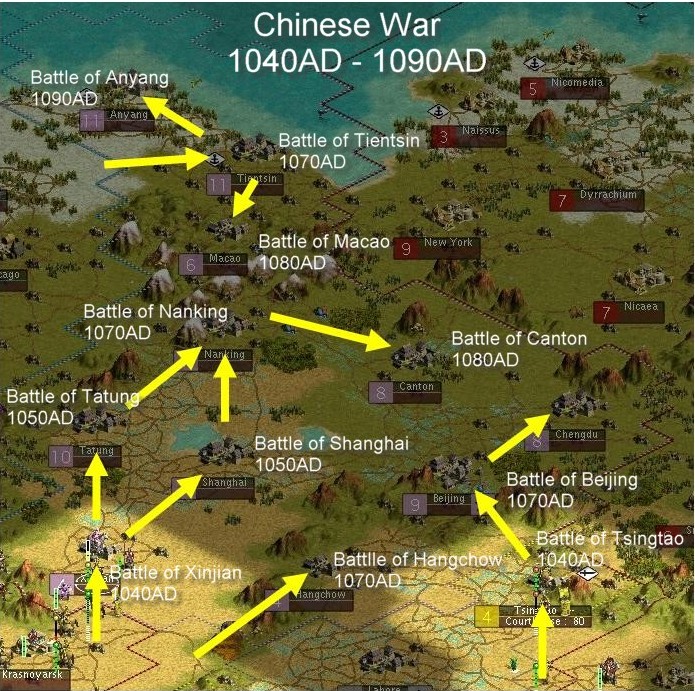
In the north, Subedei’s northern forces were now positioned to strike as well. In an offensive that took the hapless Chinese completely by surprise, Tientsin was assaulted. The brave pikemen put up a good fight, and claimed the lives of a thousand cavalry, but they simply could not resist the 7th keshik army, and the mass of cavalries that followed it, and so a further three battalions of Chinese pikemen perished as another city joined Mongolia.
In the Chinese east, the main Byzantine force had been supposed to attack Canton, and seize control there early in the campaign, but the Byzantines had failed to do this, and so Subedei aimed his forces there instead. At Canton, Kublai’s keshik army single handedly destroyed three pike battalions to seize the city. This brought the Chinese city of Chengdu within range of Subedei’s forces, and so of course he immediately ordered the assault there as well. Faced with only three pike battalions defending the city, it was expected to be another easy take, however, it turned out to be anything but. In by far the nastiest and bloodiest of the assaults in the whole Chinese campaign, the pikemen of Chengdu cost the Mongols the service of the revered Tolui, and his invaluable keshik army. In addition, they succeeded in routing the charge of a further cavalry battalion, before succumbing to the might of the desperate cavalry attacks. Though he later denied it, Subedei was down to his last, injured elite cavalry unit in the area to complete this attack, but clearly after losing Tolui, he was not going to let these Chinese resistors remain unpunished!
In the north it was simply clean up time as Chagatai led his army and an additional cavalry battalion in the capture of Macao, and the seventh keshik army required the assistance of only two cavalry battalions to finish the Chinese at Anyang.

So the Chinese with their mighty riders ultimately fell just as quickly as the backward forces of the Japanese. All that remained to see was whether the Byzantine – Mongolian Pact was to survive, or if the Mongolians had finally wearied of this odd alliance with the Byzantines?
This flanking action posed the most immediate danger to Subedei’s forces, so he ordered that it be dispatched with haste. However, protected as they were by the forests, these riders continued to put up a stiff resistance. No less than three keshik armies were employed in this battle with two facing such serious war damage from destroying only a single rider battalion, that they were forced to retreat from the field of battle. It took an elite cavalry battalion to finish off the last rider and clear this immediate danger from the area.
With the pace of these new cavalry units, and the sheer quantity of force at his disposal, Subedei was not content with a holding action, and so pushed on to the gates of the city of Tatung. Here Chagatai’s army lead three cavalry battalions through the three Chinese pike battalions and one longbow battalion to conquer the city.
Splitting his primary force in two here enabled Subedei to strike at Shanghai as well. The assault here fared a little worse, as Kublai’s army lead the charge, a thousand Mongolian cavalry were to perish there, but it was still the Mongolians day as five thousand Chinese defenders also perished to leave the town in the hands of the Mongols.
At the onset of this war, the Chinese empire consisted of the main bulk of their empire as a conglomeration of 12 settlements, and one further settlement out amongst the former German territories. It was at this isolated town of Shantung that the Byzantines really brought a concerted action to bear. Beating the Mongols to the punch, the Byzantines attacked with over a half division of knights. From within this isolated town, the Chinese defenders had no answers, and soon succumbed to the Byzantine onslaught.
With the Chinese war progressing well, the Khan was greeted with further good news form Yeh-lu. The sages had just completed their latest research project, and now understood the principles behind gravity itself!

It turned out that the democracies of the world had been vigorously pursuing knowledge as well, and so a trade opportunity existed once more with the Dutch. This new knowledge of gravity and a couple of chests of gold secured the concept of magnetism from the Dutch, and heralded in a new age for the Mongols, with many new exciting prospects to investigate. The most exciting of all, however, was a concept of rapid movement across the mighty Mongolian empire, and although this knowledge was clearly some way away, the impact was clearly going to be immense, so the sages were once again granted significant funding in order that the strategic benefits of this latest concept could be realised as soon as possible.

The lead sage on the gravity project sought the counsel of the Khan, himself. This Isaac Newton wished to celebrate this achievent with the creation of a special university that would promise to keep the Mongols well in the technology race for some time to come. Intrigued by this idea, and well satisfied with the former sage, Adam Smith, and the value of heeding his earlier similar advice, the Khan agreed to this request, and a great project under construction in the city of Ta-tu was redirected towards this university concept. The foundations of a new great project were started in the city of Tabriz.
Meanwhile, the Khan watched with amusement as the small Scandinavian expeditionary force began to founder against the might of the tiny two city state of India, to the extent that they turned for help from the Inca. Just how long could a small nation hold out these much larger aggressors? This action of the Scandinavians became even more surprising when after forcing the Incans into this battle, they then themselves withdrew and made their peace with the Indians in a truly cowardly move that would have major ramifications on their international reputation for centuries to come.
Back on the war front, while Subedei’s forces recuperated after the rapid initial advances, the Byzantines struck at the southern Chinese town of Hangchow, however, here they were repulsed. Subedei was never willing to play second fiddle to anyone, particularly an ally, so he immediately followed up the Byzantine attack with one of his own. Two battalions of cavalry were enough to crush through the pike resistance and seize control of the town.
Elsewhere, the northern advance continued. Tolui’s army led the assault on Beijing, and although two cavalry battalions were routed, the four pike battalion defenders proved unable to resist the combined forces attacking them. The assault on Nanking was led by Chagatai’s army, though again riders proved difficult opposition claiming a cavalry battalion. The Chinese losses continued to be much more severe, however, this time losing three thousand pikemen and a thousand riders before ceding the city to the Mongols.

In the north, Subedei’s northern forces were now positioned to strike as well. In an offensive that took the hapless Chinese completely by surprise, Tientsin was assaulted. The brave pikemen put up a good fight, and claimed the lives of a thousand cavalry, but they simply could not resist the 7th keshik army, and the mass of cavalries that followed it, and so a further three battalions of Chinese pikemen perished as another city joined Mongolia.
In the Chinese east, the main Byzantine force had been supposed to attack Canton, and seize control there early in the campaign, but the Byzantines had failed to do this, and so Subedei aimed his forces there instead. At Canton, Kublai’s keshik army single handedly destroyed three pike battalions to seize the city. This brought the Chinese city of Chengdu within range of Subedei’s forces, and so of course he immediately ordered the assault there as well. Faced with only three pike battalions defending the city, it was expected to be another easy take, however, it turned out to be anything but. In by far the nastiest and bloodiest of the assaults in the whole Chinese campaign, the pikemen of Chengdu cost the Mongols the service of the revered Tolui, and his invaluable keshik army. In addition, they succeeded in routing the charge of a further cavalry battalion, before succumbing to the might of the desperate cavalry attacks. Though he later denied it, Subedei was down to his last, injured elite cavalry unit in the area to complete this attack, but clearly after losing Tolui, he was not going to let these Chinese resistors remain unpunished!
In the north it was simply clean up time as Chagatai led his army and an additional cavalry battalion in the capture of Macao, and the seventh keshik army required the assistance of only two cavalry battalions to finish the Chinese at Anyang.

So the Chinese with their mighty riders ultimately fell just as quickly as the backward forces of the Japanese. All that remained to see was whether the Byzantine – Mongolian Pact was to survive, or if the Mongolians had finally wearied of this odd alliance with the Byzantines?
slyda
Chieftain
very nice, do you live in the eastern states, or WA? it doesn'y matter i just want to know approx when you post.
Similar threads
- Sticky
- Replies
- 30
- Views
- 2K
- Replies
- 10
- Views
- 767
- Replies
- 10
- Views
- 2K
- Replies
- 0
- Views
- 222
- Replies
- 17
- Views
- 2K
